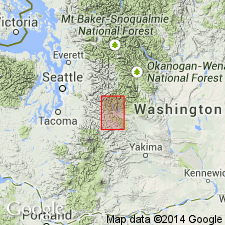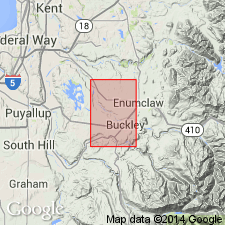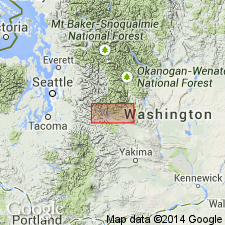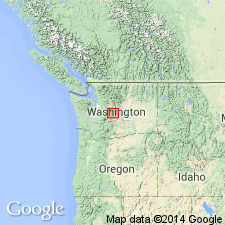
- Usage in publication:
-
- Keechelus andesitic series*
- Modifications:
-
- Named
- Dominant lithology:
-
- Andesite
- Basalt
- Rhyolite
- AAPG geologic province:
-
- Cascades province
Summary:
Probably named for Keechelus Lake, at headwaters of Yakima River, Kittitas Co, WA, where unit is well exposed on both sides of the lake. Type locality: Not evaluated to date. Consists of extensive lava flows and tuffs of andesite, and some basalt and rhyolite. Thickness [ranges from a few ft] to as much as 4000 ft. Mainly Miocene, but contains some material that is almost certainly post-Miocene in age [younger than Miocene Guye formation (new)].
Source: GNU records (USGS DDS-6; Menlo GNULEX).

- Usage in publication:
-
- Keechelus andesitic series*
- Modifications:
-
- Age modified
- AAPG geologic province:
-
- Cascades province
Summary:
Age of Keechelus andesitic series has been considered to be Oligocene on the basis of the flora (Grant, 1941) [outside of the Buckley quad], but fossil flora identified by R.W. Brown indicates that at least the lower part of the Keechelus is of middle or late Eocene (South Prairie Creek, southeast of the Buckley quad) age.
Source: GNU records (USGS DDS-6; Menlo GNULEX).

- Usage in publication:
-
- Keechelus andesite
- Modifications:
-
- Age modified
- Biostratigraphic dating
- Revised
- Areal extent
- AAPG geologic province:
-
- Cascades province
Summary:
Keechelus andesitic series (Smith and Calkins, 1906) renamed Keechelus andesite [not adopted], as author considers the original name to be inappropriate. Mapped area is considered to be type area, specifically Rampart Ridge, between Gold Creek and Little Kachess Lake (west face of Rampart Ridge at the latitude of Rachel Lake). In this area minimum thickness is at least 3500 ft. Unconformably overlies Naches formation and is intruded by Snoqualmie granodiorite. Age of the Keechelus in the Mt. Aix quad is considered to be Oligocene-Miocene on the basis of an Oreodont (Grant, 1941).
Source: GNU records (USGS DDS-6; Menlo GNULEX).

- Usage in publication:
-
- Keechelus andesite†
- Modifications:
-
- Abandoned
- AAPG geologic province:
-
- Cascades province
Summary:
Keechelus andesite [series] (Foster, 1960) is abandoned on the basis of "persuasive arguments by Waters (1961, p. 56), mainly that the name 'Keechelus' had been used too indiscriminately." Waters cites extension into areas between Skykomish basin (north) and Columbia River gorge (south). "A few . . . were based strictly on age assignment . . . but nearly all were based on partial lithologic similarity, or on dubious evidence of similar stratigraphic position . . . [leading] to much confusion concerning what is meant by 'Keechelus'. Rocks equated with Keechelus andesite by different authors range in age from Eocene to Quaternary."
Source: GNU records (USGS DDS-6; Menlo GNULEX).
For more information, please contact Nancy Stamm, Geologic Names Committee Secretary.
Asterisk (*) indicates published by U.S. Geological Survey authors.
"No current usage" (†) implies that a name has been abandoned or has fallen into disuse. Former usage and, if known, replacement name given in parentheses ( ).
Slash (/) indicates name conflicts with nomenclatural guidelines (CSN, 1933; ACSN, 1961, 1970; NACSN, 1983, 2005, 2021). May be explained within brackets ([ ]).

